1. Theme of project
2. Background and object
Ⅱ. SCM 2.0
1. Details of project activities
Ⅲ. SCM 2.0 of Sony Ericsson
Ⅳ. Conclusion
1. Introduction
2. Divide duties
1. Outline
Sony Ericsson is a joint venture established on October 3, 2001 by the Japanese consumer electronics company Sony Corporation and the Swedish telecommunications company Ericsson to make mobile phones. The stated reason for this venture is to combine Sony's consumer electronics expertise with Ericsson's technological leadership in the communications sector. Both companies have stopped making their own mobile phones.
The company's global management is based in Hammersmith, London, and it has research & development teams in Sweden, Japan, China, Germany, the United States, India, Pakistan and the United Kingdom. By 2007, it was the fourth-largest cellphone manufacturer in the world after Nokia, Motorola and Samsung. The sales of products largely increased due to the launch of the Walkman series.
2. History
1) Troubles in Ericsson's mobile phone business
In the United States, Ericsson partnered with General Electric in the early nineties, primarily to establish a US presence and brand recognition.
Ericsson had decided to source pon chips for its phones from a single source, a Philips facility in New Mexico. In March 2000, a fire at the Philips factory contaminated the sterile facility. Philips assured Ericsson and Nokia (the other major customer of the facility) that production would be delayed by less than a week. When it became clear that production would actually be compromised for months, Ericsson was faced with a serious shortage. Nokia had already begun to obtain parts from alternative sources, but Ericsson's position was much worse as both production of current models and the launch of new ones was held up.
Ericsson, which had been in the cellular phone market for decades and was the world no. 3 cellular telephone handset maker was struggling with huge losses in spite of booming sales since 2000 due to this fire and its inability to produce cheaper phones like its competitor Nokia. To curtail the losses, it was thinking of outsourcing production to Asian companies that can produce the handset for lower costs.
Speculation had begun about a possible sale by Ericsson of its mobile phone division but the company's president said that it had no plans to do that. "Mobile phones is really a core business for Ericsson. We wouldn't be as successful (in networks) if we didn't have phones," he said.
2) Background of the joint venture
Sony was a marginal player in the worldwide cell phone market with a share of less than 1 percent in 2000. It was also struggling in this area with losses but wanted to focus more in this area. In April 2001, Sony confirmed that it was in talks with Ericsson for a possible collaboration in the handset business. This was soon after Toshiba and Siemens had announced plans in November 2000 to work together on handsets for 3G mobile networks.
By August 2001, the two companies had finalized the terms of the merger announced in April. The company was to have an initial workforce of 3,500 employees.

- 오늘 본 자료가 없습니다.
- 토스 마케팅 전략 분석
- A+ 인적자원관리 - 5주차 1강에서 모집에 대하여 학습하였습니다. 인적자원관리에서의 모집은 조직의 지속가능경영에 밀접한 영향을 미칩니다. 현재 (2020년 대) 시장 상황에 맞는 효과적인 모집에 대하여 설명하시오.
- [A+ 리포트] 최근 빅데이터의 개념 및 활용 사례를 제시하고, 빅데이터 기술로 인해 발생한 문제점과 해결책을 조사하여 리포트를 작성하시오.
- SNS마케팅 개념,효과분석 및 국내,해외기업 도입사례분석과 SNS마케팅 향후방향 제시
- 경영전략론_1 산업의 수익을 결정하는 마이클 포터의 5force에 대하여 특정 산업의 예를 들어 설명하시오 2 핵심역량을 결정하는 3가지 요인과 핵심역량 전략에 관하여 사례를 통하여 설명하시오 3 4차 산업혁명에 따른 제품(product) 일하는 과정(process) 요구하는 사람과 깅버문화(people)가 어떻게 변화하여야 하는지에 관한
해당 정보 및 게시물의 저작권과 기타 법적 책임은 자료 등록자에게 있습니다. 위 정보 및 게시물 내용의 불법적 이용,무단 전재·배포는 금지되어 있습니다. 저작권침해, 명예훼손 등 분쟁요소 발견 시 고객센터에 신고해 주시기 바랍니다.




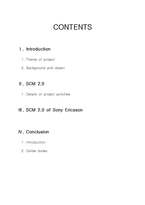
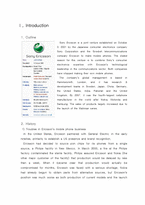
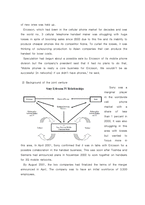
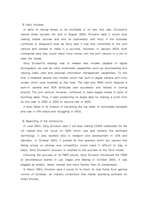
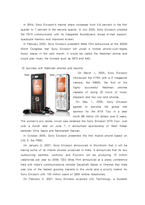
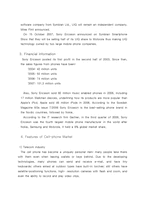
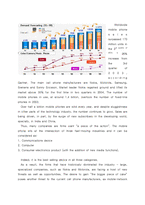
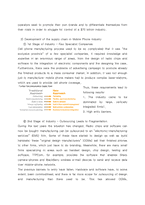

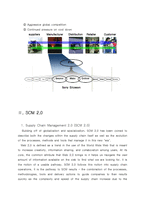
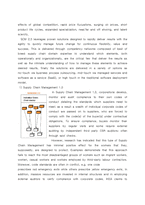
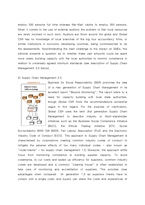
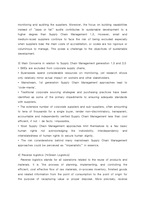

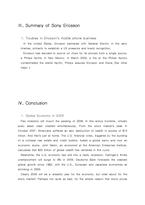
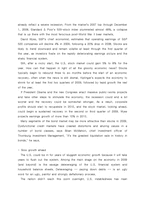

 분야
분야

